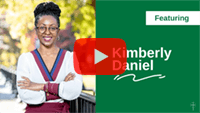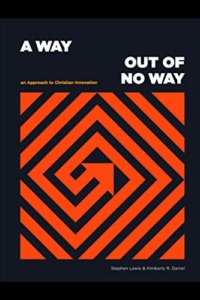
How can Christian innovation address the needs of people who are under-resourced and undervalued? Kimberly Daniel shares how Christian innovation can begin to break down barriers to wealth and flourishing.
Listen on Apple Podcasts | YouTube Music | Spotify
Watch on YouTube

- Transcript — Click or Tap to Read
-
Announcer: Leading Ideas Talks is brought to you by the Lewis Center for Church Leadership of Wesley Theological Seminary in Washington, DC. Subscribe free to our weekly e-newsletter, Leading Ideas, at churchleadership.com/leadingideas.
Leading Ideas Talks is also brought you by Sustaining While Disrupting: The Challenge of Congregational Innovation by Douglas Powe and Lovett H. Weems. This book offers theological insights and practical skills to guide church leaders in stewarding traditions while also seeking innovative opportunities for faith communities. Learn more and order now at churchleadership.com/books.
How can Christian innovation address the needs of people who are under-resourced and undervalued? In this Leading Ideas Talks episode, Kimberly Daniel share how Christian innovation can begin to break down barriers to wealth and flourishing.
Jessica Anschutz: Welcome to Leading Ideas Talks, a podcast featuring thought leaders and innovative practitioners. I am Jessica Anschutz, the Assistant Director of the Lewis Center, and I am your host for this Leading Ideas Talk. Joining me is Kimberly Daniel, the senior director of communications at the Forum for Theological Exploration (FTE). She’s the cofounder and director of Do Good X, an accelerator for diverse Christian social entrepreneurs and innovation of FTE and coauthor of A Way Out of No Way: An Approach to Christian Innovation.
Welcome, Kimberly. I was very inspired by your book and the stories you lifted up from Do Good X. I appreciated how you included interactive exercises for each of the six steps of Christian innovation, and I look forward to our conversation today. I want to invite you to start off by sharing what brought you to the work of Christian innovation.
Kimberly Daniel: Well, first, thank you for having me. I appreciate the invitation and being able to share more about Christian innovation. So, what brought me, and us, to Christian innovation? Let me go back to 2017, where Steven and I, (Stephen is President of the Forum for Theological Exploration — I’ll say FTE, for short), we had questions of what diverse leaders — Christian leaders — are seeing in their communities as it relates to innovation. What are they doing as it relates to innovation? And in our own stories, what is the innovation that has been a part of who we are in our own personal stories?
So, we hosted a series at FTE. We hosted a series of conversations, small conversations, in over five cities. Between that — bringing together community leaders, pastors, entrepreneurs — between that and the work of Do Good X that you mentioned earlier in my introduction, we really got to understand more of what’s being done in communities, what innovation is being done in communities to meet the needs of those who live in the communities. But we also got to see what Christian innovation is and what Christian innovation is not. So, that inspired us to not only look into this work but to write this book about Christian innovation because we found that a lot of what’s named innovation is really, in our perspective, not really, truly Christian innovation. And we came with that, alongside our own stories of being Black in America and knowing what frugal innovation looks like. And that is where we wound up with A Way Out of No Way. So, we were inspired to write this book and we were drawn to Christian innovation in that way.
Jessica Anschutz: So, say a little bit more about how Christian innovation is different from other forms of innovation.
Kimberly Daniel: I would say, generally speaking, innovation is coming up with a solution to a problem, a challenge, or a need; and the result of it is better than what existed before. That’s innovation generally. But for us in particular, Christian innovation is rooted in the teachings of Jesus and God’s preferential starting place of addressing the challenges and needs of people who are disenfranchised, people who are socially vulnerable, people who are under-resourced and undervalued, and allowing that to be the starting place of where innovation is rooted. That is Christian innovation.
Christian innovation for Stephen and I is ultimately what we say in the book: the ingenious grit of seeing opportunities in unfavorable circumstances and in composting available resources to create a way out of no way and persistent challenge. Even under constrained resources, you are composting, and you’re developing these solutions. Even when you see that there is literally no way of developing solutions, you see light. You see hope. You see possibilities. And you’re working within the constraints to develop something that is better than what was experienced before.
So, I would say Christian innovation specifically starts with Jesus’ teachings. I will also add to that: a lot of what we have seen is that Christian innovation has been named something attached to people or institutions when they have been able to navigate economic or cultural shifts. They come out on the other side of whatever has happened whole, and the institution has survived. That is important, and that is a form of innovation, especially as we experienced the pandemic and so many challenges in multiple pandemics. That is very important when it comes to innovation. But that is not the type of innovation we’re talking about. We’re talking about Christian innovation that is not just about a leader or an institution.
Jessica Anschutz: So how can faith specifically or Christian faith or Christian innovation inform the removal of these barriers to wealth and flourishing that you have explored?
Kimberly Daniel: Let’s say that is a big question because the barriers to wealth and flourishing are so deeply entrenched in our systems — our justice system, our economic system, all the systems. But I would say that leaders of faith in their small corners of the world, their small corners of their communities, what they can do is start to listen, start to notice, start to challenge, start to address the challenges that they see that people within their community are facing when it comes to these barriers and when they truly think about how they can empower people. Not charity. Let’s not talk about charity and giving up.
How can they empower people with the resources, with the tools, that they need? How can they platform these individuals’ voices, give them the platform to speak their own voices, not speak for them, but allow them to speak their own voices? That is a part of addressing these barriers. That’s only a small, little piece of it, but I feel that, again, going back to our definition of Christian innovation and really starting out with Jesus’ teachings and providing empowerment and resources to those who are under-resourced and undervalued, that’s something small that can be done in communities because of and being driven by your faith to do that.
Jessica Anschutz: One of the things I really appreciated about your book, Kimberly, is that you focus on some practitioners that are doing this work. Could you lift up an example or two of how they are addressing these barriers and what they are doing?
Kimberly Daniel: Sure. I’ll mention one that’s in the book and I’ll mention one that’s outside of the book because I know, in a lot of conversations, I mentioned the wonderful leaders there in this book, but I also want to lift up some others who have come up in our work.
One that I’ll mention is Kit Evans-Ford, Dr. Kit Evans-Ford. She is doing the work of Christian innovation. She is a spiritual director. She has been a professor, and she participated in the 2017 Do Good X Startup Accelerator. Through her business, her social enterprise, which she sees as her ministry, she is addressing and providing space and support for women who are healing from domestic violence and abuse. She is providing sources of income for them because she employs them. She’s providing a community where they create these beautiful, healing bath and body products to be able to send this healing to others in the world.
But if she is also offering a community of support through holistic services, through providing spaces for these women to stay when they’re exiting out of these situations. And this is a part of Kit’s own story and Argrow’s [House], which is named after her grandmother who faced this as well. So, through Kit’s work, she is starting with Jesus’ teachings. She is starting with focusing on women who are healing who have been survivors, who are survivors, and who have not always had the resources to move forward in their life. And she is providing them with those resources and a community.
I’ll also mention Rev. Dr. Heber Brown, who is the founder of the Black Church Food Security network. He was formerly the pastor of Pleasant Hope Baptist Church. What he saw, walking out in his community in Baltimore, was that there was a food mirage. He calls it a food mirage. What that means is that food was there, healthy food was there, but it wasn’t accessible to people in his community because of the cost. And people within his community and congregation at the time were having diet-related issues.
So, he looked where his church was, and there was a plot of land, a small, little corner. And what he did was he grew produce for the community. In one of the earliest years of the Black Church Food Security Network, they grew over 1,200 pounds of food to provide to the community. That has now grown to really have an alliance of hundreds of churches, black churches, who are in communities where they were just maintaining the land — the lawn maintenance — and now shifted that to actually grow food and produce and work with black farmers to give back and provide access to healthy food within their community — again starting with God’s preferential starting place and giving access to people who couldn’t afford healthy food that would ultimately have an impact on their physical, mental, and even maybe emotional well-being, with what they’re taking into their bodies.
Jessica Anschutz: What inspiring examples you have lifted up, and they’re powerful in not only how they address issues of injustice and scarcity and redistribution of resources, but also really meet the needs of the people right in the community where these folks are serving.
One of the things that comes through in the examples you’ve just given, Kimberly, and you also lifted up in the book is being curious — wondering why things are the way that they are. I’m wondering if you can share with our listeners how they can begin to get curious and how they might then respond to their experience.
Explore strategies your congregation can use to reach beyond its walls with worship, community events, ministries, and service. The Taking Church to the Community Tool Kit features engaging videos and presentations and is designed for both self-study and for use with groups in your church. Learn more and watch introductory videos now.
Kimberly Daniel: Yes, getting curious is so important to truly developing solutions that are needed in communities. I would encourage people to get curious about why things are the way that they are within particular communities. Get curious about what is even a challenge or a need in the community. Part of this work of getting curious is about listening. It’s not always about speaking. It’s about truly listening to people, truly observing what’s going on, and really trying to set aside our own kind of interest, and really seeing what the needs are, and getting curious about them. When Stephen and I talk about getting curious, it’s always asking questions of why. Why is it this way or how did it get this way? Or what can potentially be done to heal this? So, it’s really doing some reflection and asking questions not just of ourselves but people around us, particularly if your work is based in and addressing a community that you’re not from. That’s so, so important.
Jessica Anschutz: And the process of asking those questions of your neighbors, of the people in the community, is a way of leading into deeper relationship and deep and even deeper listening. One of the next steps you lift up is about making meaning and the importance of staying curious so that you can make meaning. What does meaning making look like when it comes to Christian innovation?
Kimberly Daniel: Meaning making — when it comes to Christian innovation, we talk about it in three ways. It’s about reflecting, reckoning, and interpreting.
Reflecting is about working with people within your communities, to really get curious and address why things are the way that they are, and to do some reflection, again, not just with yourself (that’s important) but with people who are within the community.
Then it’s also about reckoning. So, that’s still upholding this piece of getting curious (but that’s about the why) so you see what exists within the community. You wonder why things are the way that they are, why people aren’t receiving what it is that they need, and what needs to be reckoned in order to address what you’ve reflected on.
And then you interpret it. And this is where you can begin to really look at potential solutions — after you’ve identified the problem and gotten clear about that. So, you’re looking at what’s the cause. You’re looking at who actually benefits from what is happening in the community and who really needs to benefit in order for us to address what is also named in the Bible and some might say the least of these or people who are again undervalued or underserved. Again, when we’re talking about meaning making, we’re talking about reflecting, we’re talking about reckoning and interpreting in order to get to a potential solution.
Jessica Anschutz: You’ve alluded a little bit, Kimberly, to the need for church leaders to do their own work but to also be sure that they are setting aside their own preconceived notions and truly listening deeply to those around them, particularly in contexts where you may not match the community that you’re situated in. In thinking about that, what words of advice or wisdom do you have for church leaders to do that work personally and then to set aside their preconceived notions about what may be needed or what may need to be done?
Kimberly Daniel: That is a good question. I would say it is important to know what your own preconceived notions are, what your own assumptions are that you carry, because that can cloud your judgment if your assumptions are not actually right. And there also needs to be a level of discernment, too, because the work of particular communities is not for all leaders to do. So, you have to discern if you are even the right person or if you should come alongside someone else as an ally and partner in the work who may be a better fit for charging the efforts. Then you come alongside them. Or maybe it’s not something that you should do at all.
I think, in a church leader’s own reflections, it’s identifying their assumptions. It’s discerning if they’re the person to do the work or if it’s someone else. And when you go outside of yourself — sometimes it can actually be helpful to ask others who are in your close-knit community about the assumptions that they have heard you have and carry in your own leadership so that you can hear the wisdom of the community, because sometimes they can help you to see things that you don’t see yourself.
Jessica Anschutz: I think that’s really powerful advice, and also an excellent warning in that you shouldn’t just wake up one day and decide to go out and “I’m going be an innovator. I’m going to resolve this problem or this situation that I see.” That may not be the problem or situation that my neighbors see or want to have resolved.
Kimberly Daniel: Yes, I completely agree with that because I also think what can happen, too, is that someone thinks that it’s a problem, and it’s not actually a problem for the community that they’re trying to help. They have good intentions, but good intentions don’t always yield positive results.
Jessica Anschutz: That is certainly true. One of the things that I have seen church leaders do is expend a lot of energy on generating ideas, putting together plans, and have committee meeting after committee meeting and those plans never get put into action. I want to invite you to perhaps share from your experience: how can church leaders really experiment with solutions and move from planning into action?
Kimberly Daniel: Do it. I know it sounds like I’m just, you know, quoting Nike: “Just do It.” Moving plans into action — there’s one church leader I talked to recently and I asked, “What is the community losing or not gaining because your work is stuck in your head or stuck on your whiteboard or stuck on your computer or stuck in conversations?” Church leaders — yes, there is a tendency to come up with these great ideas, some not so great ideas, but you don’t even know if they will work because they don’t go beyond the paper. So, I would suggest — and this is something we do in our accelerator program and with innovative leaders — how can you test out if your idea and your plan even works? What is something incremental? Maybe you can’t take the full-scale vision and bring that to life yet because of constraints of capacity, of finances, or what have you. But I would say, how can you experiment with the idea that you came up with so that you know? And you can take those steps to bring these ideas that you have from the paper to life. I’ll also kind of put on my life coaching hat where it’s like, “Okay. What are your goals? What’s your plan of action here? What is actually a plan of action? What are you going to do with the next month, three months, six months, a year?” But, at the end of the day, it all goes back to my question. What is your community losing because you’re not allowing your ideas to actually be taken from paper and into context, into action, to help your community?”
Jessica L. Anschutz: I think that’s excellent advice and wisdom and helpful in a lot of cases, even beyond Christian innovation. One of the things I’m wondering about is you talk about sort of testing the viability of the solution. Right? Can you test a piece of it? is there an example you could lift up from somebody that’s gone through one of your programs about how they tested something and perhaps changes or adaptations they made along the way?
Kimberly Daniel: Sure. I will go back to Kit since I’ve mentioned her story earlier. And I can also name some other examples. Going through the program, Kit was still a professor, and she experimented with her idea to develop this social enterprise, selling bath products, and empowering women who are healing from domestic violence and abuse. She put on her scientist hat in the evening after work. She has children and she has a husband. And she would put her scientist hat on and experiment with different ingredients to create these products, these healing products, because she knew what she wanted to offer to the women. But in order for them to be employed to actually create a product people wanted, she had to get clear and experiment with what exactly that product is. She started out with a bath bomb, and she had to keep on experimenting because it would discolor the tub, it didn’t hold together, or it didn’t have the smell that she desired. So, she experimented, and she ultimately came up with a product that works and that was salable, that she could sell. She has pivoted, and she has learned along the way. But I name her because this is a product that it’s very clear that she experimented with in order to develop what she has now, which is an array of beautiful products of soap and bath bombs and lip balms and all types of things that she offers now that built upon that experimentation to make sure it met the needs of people she was selling products to in order to give back to these women who she’s creating this community for. So, there’s this cycle and, you know, she had to experiment in order to ultimately impact these women. That’s one example of experimentation.
If we go back to even Heber’s story — now, Heber did not go through the accelerator program or anything, but he is someone in our network. Heber experimented by using the land of the church that he was pastoring in order to grow produce to see if it was — even though he saw that it was — needed in his community. This is something that he did, and he led these endeavors in order to see if it would work for the community, and from that he has been able to scale it to now become the Black Church Food Security Network.
Jessica Anschutz: Two very different yet inspiring examples of Christian innovation. Thank you so much, Kimberly. Again, the book is A Way Out of No Way: An Approach to Christian Innovation. Kimberly, for our last question today I want to invite you to just share words of wisdom. If folks are looking to innovate, what would you want them to have in their toolkit or have in mind before they go out to do this work?
Kimberly Daniel: I would say to come with a sense of curiosity, playfulness — because in play comes imagination and inspiration. I would also say to come with thought partners who reflect the type of people that you hope to impact and your innovative solutions and who can come with diverse ways of thinking and perspectives that may challenge you. But it will give light to the wisest solution that can exist and impact your community the most. Curiosity, playfulness, and also being mindful of not just writing these ideas down on Post-it notes, whiteboards — to your earlier question, getting stuck on agendas, but actually taking this to life, and knowing most importantly that this work of Christian innovation should be grounded in the teachings of Jesus and the preferential starting place that God talks about in order to be true Christian innovation. In doing that, you are living out your faith; you are doing the work that the community needs.
Jessica Anschutz: Thank you so much, Kimberly, for taking the time to be with us today. It’s been a joy to talk with you. I wish we had more time to hear more of the stories. But I recommend your book, and hope that more folks will check it out as they seek to engage in Christian innovation.
Kimberly Daniel: Thank you for the opportunity to chat today. I appreciate you, appreciate the platform, and I appreciate the work that you all are up to.
Announcer: Thank you for joining us for Leading Ideas Talks.
Don’t forget to subscribe to our free weekly e-newsletter, Leading Ideas, to be notified when new episodes are published. Visit churchleadership.com/leadingideas.
 Related Resources
Related Resources
- A Way Out of No Way: An Approach to Christian Innovation (BookBaby 2020) by Kimberly R. Daniel and Stephen Lewis. Available at BookBaby and Amazon.
- Sustaining While Disrupting: The Challenge of Congregational Innovation (Fortress Press: 2022) by F. Douglas Powe Jr. and Lovett H. Weems Jr. Available at Fortress Press, Cokesbury, and Amazon.
- Christian Social Innovation Starts with Who, Not Why or How by Kenda Creasy Dean
- Ideas on a Deadline: An In-depth Interview with Phil Cooke
- Taking Church to the Community Video Tool Kit





